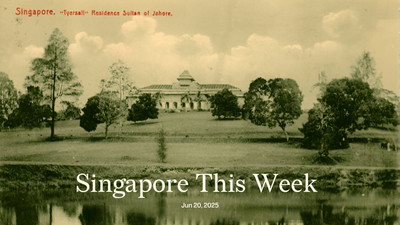Society: Cops killed in Johor
“The suspect is not affiliated with any terrorist groups and has no connection to JI [Jemaah Islamiyah]. He is not involved in terrorism,” said Razarudin Husain, Malaysia’s inspector-general of police, on Saturday. He was referring to a deadly attack last Friday in the town of Ulu Tiram, Johor, under 20km from the Causeway. Before 3am, a man, using a machete and then a pistol he stole, killed two police officers and injured another before himself being shot. Though initial reports said that his father is a JI member, and a former JI compound is in the area, the Malaysian authorities quickly moved to shut down speculation about terrorist links. “I also believe in the wisdom of our enforcement agencies in carrying out investigations, so we leave it to them,” said Ahmad Maslan, Malaysia deputy works minister.
Unsurprisingly, Singaporean hawks went into overdrive. On Saturday CNA reported that the Malaysian police have arrested over 20 suspected JI members. In reality, they had arrested seven people, with no stated terrorist links, and were “tracking down” 20 JI members. For its falsehood that may have deterred some Singaporeans from travelling to Johor over the weekend, CNA later published an apology. On Tuesday, four days after Razarudin’s statement, Lawrence Wong, prime minister, said that this attack “is a grim reminder that the threat of terrorism remains high.” Perhaps Wong, bestowed with the clairvoyance of his new office, knows something about the attacker that the Malaysian authorities don’t. Wong could have instead used the opportunity to express confidence in them—the same people who caught Mas Selamat, a certified JI operative, after the Singaporean authorities let him slip away. On Wednesday, JI’s founder, who has been called a “changed man” by the Indonesians, condemned the attack.
To be clear, Singapore must remain vigilant about terrorism, our primary national security threat. But it’s just as important to label crime accurately and not indulge our paranoias. Decades of fear mongering about the threats from Malaysia and Indonesia have harmed relations with our dear neighbours. If subsequent investigations show that the attacker was a terrorist, then we must call him such. Till then, best to stick to the facts. It’s not just the lone wolf we must worry about, but the ones who cry wolf.
Society: On Jurong side of the tracks
It’s election season in India and the formidable propaganda machine of the ruling Bharatiya Janata Party (BJP) is firing on all cylinders. Recently, some of the party’s regional X accounts posted a photo of Narendra Modi, the prime minister likely to win a third term, with a caption hailing the BJP’s role in improving train services in Indian cities. There was just a tiny oversight. The slick train in the background belongs to SMRT, and was departing from Jurong East. Shawn Ang, a Singaporean photographer, had uploaded it to the image site Unsplash.
Singapore looms large in the Indian imagination, the shimmering Atlantis at the far end of the ocean that sets the benchmark for all urban development. In 2021, much to environmentalists’ chagrin, Niti Aayog, the Indian government’s premier public policy arm, proposed converting an island in the Andaman and Nicobar archipelago into a free trade zone and tourist magnet which would compete with Singapore and Hong Kong. The irony of this new “Little Singapore” in the Andamans was not lost on some. In the 1850s-60s, Straits merchants protested against Singapore’s continued use as a penal colony—it was bad for the brand and anyway, convict labour could easily be replaced by waves of Chinese migrants. And so the British sent most of the prisoners to the Andaman jails.
Numerous other cities lay claim to being the “Singapore of India”, including Nuh, an aspiring start-up hub notorious for cyber-crime, and Gurgaon, a bleak glass and concrete behemoth abutting Delhi, the national capital. Alongside this fetish for Singapore thrives an abiding middle-class passion for Lee Kuan Yew—the strongman leader who willed an entire first-world country into existence by imposing order, discipline and obedience. In 2016, in a bid to legitimise Modi’s disastrous decision to demonetise 86 percent of the country’s currency, the BJP’s internet brigade circulated a craftily edited image purporting to be an article from a Singapore newspaper. The headline: “A New Lee Kuan Yew is Born in India”. A year earlier, Open Magazine, a right-leaning publication ran an article titled “Can Modi be India’s Lee Kuan Yew?” The time since has shown he can be, as far as hollowing civil society and targeting rivals goes. As for planning, growth and safety? That train has barely left the station.
Society: Mixed feelings about going co-ed
Maris Stella High School is the latest school to announce that it will become co-educational, more than a year after Anglo-Chinese School (Primary) did so. Both schools will start accepting girls after relocating in 2027 and moving to a new campus in 2030, respectively. The news has revived age-old debates around single-sex versus co-ed education: which is better for the child and for whom, females or males? On the one hand, proponents for not mixing the sexes have argued, rightly or wrongly, that a co-ed environment is more likely to benefit boys than girls, since the latter is a more positive influence—girls typically mature earlier and do better at school. Some research has also found that girls perform better academically without the distraction of their male counterparts, such as being exposed to potential sex-based harassment as they navigate the “complexities of body image and self-esteem”.
On the other hand, advocates for a mixed-sex educational environment assert that it better prepares students for the “real world” as it fosters the “life skills of teamwork, emotional intelligence, mutual understanding and the ability to relate to others”, while promoting more balanced relationships. “...[S]tudents need to learn mutual respect and the social skills of interacting,” said Diane Halpern, a psychology professor. “We don’t have sex-segregated workplaces, so why would we have sex-segregated schools?” Halpern has said that single-sex environments may foster gender stereotyping and sexism, which can lead to hypermasculine behaviours.
Whichever way you lean, the shift appears inevitable. No new single-sex schools have been established here since the 1960s. While changes in urban density, shrinking family sizes and a plummeting fertility rate means schools will face continual challenges to meet shifting community needs. All this points to an education system that’s likely to become more co-educational. Girls and boys will simply need to learn to co-exist earlier in a social setting. But does this mean our sexuality education curriculum will have to move with the times and be delivered to students at an earlier age? If so, preaching abstinence may not suffice to keep raging adolescent hormones at bay. If it ever did.
History weekly by Faris Joraimi
Malaysian archaeologists made major discoveries at Bukit Choras in Kedah recently, including a stupa, two Buddha statues and a stone inscribed in Pallava script (a writing system used for the Malay language between the seventh and fourteenth centuries CE). Nasha Rodziadi Khaw, the Penang-based head excavator, believes the finds date back to either the eighth or ninth centuries CE. That’s about 1,200 years ago, when the Srivijaya empire flourished, while elsewhere, the Tang dynasty ruled China and the Vikings raided European shores. Located in the Bujang river valley, Bukit Choras is just one of 97 sites that suggest the existence of a thriving trading polity based on Hindu-Buddhist tradition. Among the remains are port facilities, monumental structures and foundries for smelting iron, an advanced technology for the time that needed complex infrastructure.
Together, the sites are among peninsular Malaysia’s oldest evidence of human settlement and culture (although “prehistoric” human remains from as far back as 11,000 years have been found in Perak). British officers described some of the Bujang Valley sites in the mid-19th century, but thorough excavation was only done in the last 20 years, with work on Bukit Choras finally begun in August 2023 continuing through the first half of this year. What makes Bukit Choras special is the stupa’s large size relative to its isolation from the rest of the Bujang Valley sites, meaning it was probably a major population centre. Khaw says we don’t know enough to determine its role, but it could have been a military outpost or coastal trading hub.
Why should Singaporeans bother about the Bujang Valley? For one, it’s part of the ancient story of the Melaka Straits as an international trade route: almost the only reason Singapore exists. As Malaya’s erstwhile colonial headquarters, Singapore was key to early attempts at documenting the valley’s history. Most of the Bujang Valley’s objects found during colonial excavations were first sent to the Raffles Library and Museum (today’s National Museum of Singapore), where they’ve remained even after our separation from Malaysia. As Malaysian and Singaporean history continue to be political battlegrounds involving race and religion, the stupas of the Bujang Valley are no silent ruins.
Arts: South-east Asia looks back
Three men, their backs to the camera, walk through a denuded landscape of tree stumps and felled branches. Round the corner, an elephant’s eye gazes back at us, an amber marble in a craggy valley of wrinkles. Then there’s a group of middle-aged friends, mid-song, fingers curled around mugs of beer and each other’s arms. Taken together, these three image-based projects—all winners of the 2023 Objectifs Documentary Award—tell converging stories of marginal communities in and from South-east Asia as they confront processes of destruction, displacement and relocation. This potent exhibition at the film and photography centre is the culmination of a year of mentorship under the auspices of the annual award, now in its sixth edition. (There’s an ongoing open call for the next one, closing on Monday.) The award celebrates visual storytelling about its recipients’ native communities, and encourages a wide range of approaches to image-making, from more conventional documentary photography to visual experiments that play with methods of installation and display.
Winner Choulay Mech, in particular, combines photography, video and found objects as a poetic vehicle for her long-term project, “An Elephant’s Eye”, where she meditates on the spiritual and cultural significance of elephants in her home country of Cambodia. A long chain, suspended from the gallery ceiling, gestures towards the gentle giants’ forced labour. An offering of fresh bananas rests atop a pedestal. The filmmaker-photojournalist also plays with scale: peer inside a miniature “spirit house” encircled by a small moat of sweets, and you’ll get a glimpse of the tiniest video of the largest creatures. Amidst the ongoing environmental destruction in Cambodia, partly Singapore’s doing, Choulay’s work compels us to pay attention to how these animals are both exalted and exploited, and what we might learn from them. The other winners do the same. Kaleb Sitompul (Indonesia) surveys the dwindling ancestral forests of Toba that a commercial corporation is terraforming, reducing these indigenous lands from a complex ecosystem into a monoculture; Lê Nguyên Phương (Vietnam) chronicles diaspora in the sun-bleached suburb of Sunshine in Melbourne (Naarm). In so many of the exhibition’s images, the subjects—elephants and indigenous landowners alike—look back at the viewer and demand that we do not look away. In a frenetic city and attention economy where we’re shorn of time to truly pay attention, this show, running till June 16th, is a call to attend to the human, plant and animal neighbours of our region.
Arts: Heng ah, finally a doctor
No more imposter syndrome for theatre director Ivan Heng, who found out during a rehearsal for “Tartuffe: The Imposter” that he was about to get an honorary doctorate. The hyper-prolific founder of popular theatre company Wild Rice will be receiving the title from his alma mater, the Royal Conservatoire of Scotland. He won a scholarship to study theatre there in 1990, and since graduating has created some of Singapore’s most recognisable characters (such as the kebaya-armour-clad Emily Gan, fearsome matriarch of “Emily Of Emerald Hill”) and directed some of its most prominent plays (including the five-hour historical epic “Hotel”, which Jom reviewed). Under his artistic directorship, Wild Rice has built a reputation for unflinching socio-political commentary, advocated for queer rights, and raised enough money to build its own theatre, no small feat in venue-starved Singapore. More than a million audience members have seen a Wild Rice work since Heng established it in 2000. He will be receiving the degree on July 4th alongside musician Vashti Bunyan and choreographer Akram Khan, whose work has also been frequently staged in Singapore. (Khan’s dance-theatre production “Jungle Book reimagined” played at Esplanade earlier this year.) An honorary doctorate waives the usual research and dissertation requirements for a doctoral degree, and is often a university’s way of honouring the recipient’s distinguished body of work, or outstanding contributions to their field or community. Heng told The Straits Times: “The first thought that came to me was that I fulfilled my parents’ wish for me to be a doctor—not in medicine but in theatre, in the arts.”
Tech: PropertyGuru might go private again
The reported potential buyout of PropertyGuru Group by private equity giants KKR and TPG highlights the growing interest in Singapore’s real estate technology sector. As existing major shareholders with a combined stake of over 56 percent, their exploration of a full acquisition or engagement with other global investors underscores PropertyGuru’s perceived value and growth potential in its online property marketplace. This comes off the back of PropertyGuru’s share price surge of 32 percent in 2024, which elevated its market value to US$723m (S$975m). While the company showed narrowing losses (S$10.1m in previous quarter to S$6.3m current quarter) and 11.9 percent revenue growth to S$36.4m driven by Singapore operations, the fact that it missed its earnings estimates could prompt strategic reassessment by the major shareholders. KKR and TPG’s expertise in buyouts could provide PropertyGuru with resources to strengthen its competitive position while reducing resources to meet regulatory and reporting requirements. However, the early stage of discussions suggests various options are being evaluated, not necessarily leading to a full buyout. Alternative scenarios could involve attracting additional investors or restructuring existing shareholdings to align with long-term strategic objectives. Nonetheless, the prominent private equity firms’ interest underscores the resilience of tech companies operating in Singapore’s real estate sector and potential for buyouts even after a company has gone public. How PropertyGuru responds to the recently announced Housing and Development Board’s free home listing service will also be crucial in determining its competitive positioning and future strategic direction.
Tech: Eat Just hopes you just eat
The launch of GOOD Meat 3, the world’s first lab-grown meat product, by Singapore-based Huber’s Butchery in partnership with Eat Just, marks a significant milestone for the cultured meat industry. Despite containing only three percent animal cells, this product represents a crucial step towards mainstream acceptance and commercialisation of lab-grown meat. While the product’s pricing at S$7.20 for a 120g portion is notably higher than traditional meat products, positive consumer feedback during testing on taste, texture, and appearance suggests a potential for market acceptance. However, high prices have historically deterred customers from purchasing plant-based meat alternatives, posing a challenge for widespread adoption. The launch comes at a critical juncture for the cultured meat sector, which has witnessed a significant decline in capital inflow, raising only US$226m (S$304.9m) in 2023 compared to US$922m (S$1.24b) the previous year. Companies like Eat Just face immense pressure to enhance cost efficiency and profitability, compounded by legal and financial hurdles. Despite suspending operations in Singapore earlier this year, Eat Just’s partnership with Huber’s Butchery has allowed them to resume production in Singapore. The company aims to produce more chicken-alternative products this year than in all previous years combined, underscoring its commitment to the cultured meat market.
If you enjoy Jom’s work, do get a paid subscription today to support independent journalism in Singapore.








